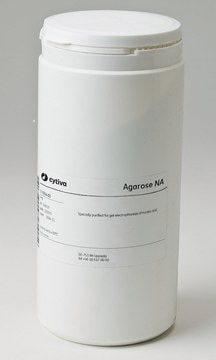A9414
Agarose, low gelling temperature
BioReagent, for molecular biology
Synonym(s):
3,6-Anhydro-α-L-galacto-β-D-galactan, LMP agarose, 2-Hydroxyethyl agarose
About This Item
Recommended Products
biological source
algae (red)
Quality Level
grade
for molecular biology
product line
BioReagent
form
powder
EEO
≤0.10
mp
≤65 °C
transition temp
congealing temperature 26-30 °C
gel strength
≥200 g/cm2 (1% gel)
anion traces
sulfate (SO42-): ≤0.10%
suitability
suitable for electrophoresis
suitable for molecular biology
foreign activity
DNase, RNase, NICKase, none detected
General description
Application
- for gel electrophoresis, low melting temperature is ideal for DNA extraction from gel -gel scaffold material for tissue engineering using BMSCs
- to embed tissues in 5% agarose for immunohistology
- for preparation of collagen-agarose co-gels to study collagen-matrix interactions in soft tissues
- single-celled gel electrophoresis (comet assay)
- for in-vivo 3-D imaging of zebrafish larvae immobilized on agarose strips
Features and Benefits
- BioReagent suitable for gel electrophoresis
- Band separation range: 200 bp - 25 kB - low gelling temperature is ideal for cell culture and viral plaque assays
- low melting point (LMP) gel is compatible with several DNA recovery methods: phenol/chloroform extractions, recovery columns, electroelution, Beta-Agarase, and freeze/squeeze
- Guaranteed quality tested for use in molecular biology, free of DNase and RNase
Analysis Note
Sulfate content - used as an indicator of purity, since sulfate is the major ionic group present.
Gel strength - the force that must be applied to a gel to cause it to fracture.
Gel point - the temperature at which an aqueous agarose solution forms a gel as it cools. Agarose solutions exhibit hysteresis in the liquid-to-gel transition - that is, their gel point is not the same as their melting temperature.
Electroendosmosis (EEO) - a movement of liquid through the gel. Anionic groups in an agarose gel are affixed to the matrix and cannot move, but dissociable counter cations can migrate toward the cathode in the matrix, giving rise to EEO. Since electrophoretic movement of biopolymers is usually toward the anode, EEO can disrupt separations because of internal convection.
Other Notes
Storage Class Code
11 - Combustible Solids
WGK
WGK 3
Flash Point(F)
Not applicable
Flash Point(C)
Not applicable
Personal Protective Equipment
Certificates of Analysis (COA)
Search for Certificates of Analysis (COA) by entering the products Lot/Batch Number. Lot and Batch Numbers can be found on a product’s label following the words ‘Lot’ or ‘Batch’.
Already Own This Product?
Find documentation for the products that you have recently purchased in the Document Library.
Customers Also Viewed
Our team of scientists has experience in all areas of research including Life Science, Material Science, Chemical Synthesis, Chromatography, Analytical and many others.
Contact Technical Service

